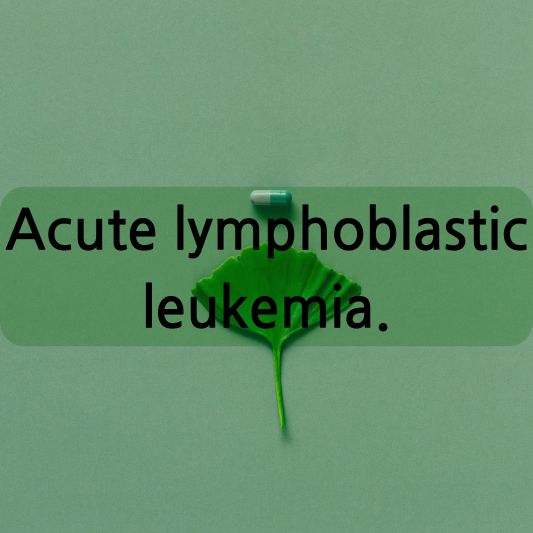Acute lymphoblastic leukemia (ALL) is a type of cancer that affects the blood and bone marrow. It is characterized by the rapid production of abnormal white blood cells, which interfere with the production of normal blood cells. This article aims to provide a comprehensive overview of ALL, including its causes, symptoms, diagnosis, treatment options, prognosis, and impact on patients’ lives.

What is Acute Lymphoblastic Leukemia?
Acute lymphoblastic leukemia (ALL) is a cancer of the blood and bone marrow. It occurs when the bone marrow produces a large number of immature lymphocytes, a type of white blood cell. These abnormal cells multiply rapidly, crowding out healthy blood cells and impairing the body’s ability to fight infection.
Subtypes of ALL
There are several subtypes of ALL, classified based on the type of lymphocyte affected and other factors. The two main subtypes are B-cell ALL and T-cell ALL, named after the type of lymphocyte involved in the cancerous growth.
Causes and Risk Factors
The exact cause of ALL is unknown, but certain factors may increase the risk of developing the disease.
Genetic Predispositions
Genetic abnormalities, such as chromosomal mutations, can increase the risk of developing ALL.
Environmental Factors
Exposure to high levels of radiation or certain chemicals, such as benzene, may also increase the risk of developing ALL.
Signs and Symptoms
The signs and symptoms of ALL can vary depending on the individual and the stage of the disease.
Common Symptoms
Common symptoms of ALL include fatigue, weakness, frequent infections, fever, easy bruising or bleeding, bone pain, and swollen lymph nodes.
Signs in Children vs. Adults
Children with ALL may also experience symptoms such as poor appetite, weight loss, and irritability. In contrast, adults may experience symptoms such as night sweats and abdominal pain.
Diagnosis and Screening
Diagnosing ALL typically involves a combination of blood tests, bone marrow biopsy, and imaging studies.
Blood Tests and Bone Marrow Biopsy
Blood tests can detect abnormal levels of white blood cells, red blood cells, and platelets. A bone marrow biopsy may be performed to examine the cells in the bone marrow.
Imaging Studies
Imaging studies, such as X-rays, CT scans, or MRIs, may be used to determine the extent of the disease and identify any complications.
Treatment Options
Treatment for ALL usually involves a combination of chemotherapy, radiation therapy, and stem cell transplant.
Chemotherapy
Chemotherapy is the main treatment for ALL and involves the use of drugs to kill cancer cells.
Radiation Therapy
Radiation therapy uses high-energy rays to destroy cancer cells and shrink tumors.
Stem Cell Transplant
A stem cell transplant may be recommended for patients with high-risk or recurrent ALL. It involves replacing diseased bone marrow with healthy stem cells from a donor.
Management and Supportive Care
Managing the side effects of treatment and providing supportive care is an essential part of managing ALL.
Managing Side Effects
Common side effects of treatment may include nausea, vomiting, hair loss, and fatigue.
Psychological Support
Patients and their families may benefit from counseling or support groups to help cope with the emotional challenges of living with ALL.
Prognosis and Survival Rates
The prognosis for ALL depends on various factors, including the patient’s age, overall health, and response to treatment.
Factors Affecting Prognosis
Factors that can affect prognosis include the subtype of ALL, the presence of genetic abnormalities, and the patient’s response to treatment.
Survival Rates in Different Age Groups
Overall, the survival rates for ALL have improved significantly in recent years, especially in children. However, the prognosis may be less favorable for older adults.
Current Research and Advancements
Ongoing research is focused on developing targeted therapies and immunotherapies for ALL.
Targeted Therapies
Targeted therapies aim to identify and attack specific molecules or pathways involved in cancer growth, minimizing damage to healthy cells.
Immunotherapy
Immunotherapy harnesses the body’s immune system to recognize and destroy cancer cells. It shows promise as a treatment option for ALL.
Lifestyle and Prevention Tips
While there is no sure way to prevent ALL, certain lifestyle choices may help reduce the risk.
Healthy Lifestyle Choices
Maintaining a healthy diet, exercising regularly, and avoiding exposure to harmful chemicals can help reduce the risk of developing ALL.
Genetic Counseling
Individuals with a family history of leukemia or other cancers may benefit from genetic counseling to assess their risk and explore preventive measures.
Coping Strategies for Patients and Families
Coping with a diagnosis of ALL can be challenging, but there are strategies that can help.
Support Groups
Joining a support group can provide emotional support and practical advice for patients and their families.
Integrative Therapies
Complementary therapies such as acupuncture, massage, and yoga may help alleviate symptoms and improve quality of life.
Impact on Quality of Life
Living with ALL can have a significant impact on physical, emotional, and social well-being.
Physical Effects
Treatment for ALL can cause a range of physical side effects, including fatigue, nausea, and hair loss.
Emotional and Social Impact
Coping with the emotional and social challenges of living with ALL may require support from healthcare professionals, family, and friends.
Awareness and Advocacy Efforts
Raising awareness about ALL and advocating for research funding are essential for improving outcomes for patients.
Promoting Education and Understanding
Educating the public about the signs and symptoms of ALL can help facilitate early detection and prompt treatment.
Fundraising Initiatives
Supporting fundraising initiatives for leukemia research can help accelerate the development of new treatments and improve patient care.
Stories of Hope and Survival
Despite the challenges of living with ALL, many patients find hope and inspiration in their journey to overcome the disease.
Personal Testimonials
Sharing personal experiences can provide encouragement and support to others facing similar challenges.
Success Stories
Highlighting success stories of patients who have overcome ALL can offer hope to those currently undergoing treatment.
Conclusion
Acute lymphoblastic leukemia is a challenging disease that requires comprehensive treatment and support. By understanding the causes, symptoms, diagnosis, and treatment options for ALL, patients and their families can make informed decisions and improve their quality of life.
FAQs
Is acute lymphoblastic leukemia curable?
While ALL can be aggressive, it is often curable, especially in children. However, the prognosis depends on various factors, including the subtype of ALL and the patient’s response to treatment.
What are the long-term side effects of treatment for ALL?
Treatment for ALL can cause long-term side effects such as infertility, heart problems, and secondary cancers. However, these risks vary depending on the type and duration of treatment.
Can acute lymphoblastic leukemia be prevented?
There is no sure way to prevent ALL, but maintaining a healthy lifestyle and avoiding exposure to harmful chemicals may help reduce the risk.
How is acute lymphoblastic leukemia diagnosed?
Diagnosis of ALL typically involves blood tests, bone marrow biopsy, and imaging studies to confirm the presence of abnormal cells and assess the extent of the disease.
What support is available for patients and families dealing with ALL?
Patients and families affected by ALL can access support groups, counseling services, and integrative therapies to help cope with the emotional and practical challenges of living with the disease.
More on Acute Lymphocytic Leukemia!
